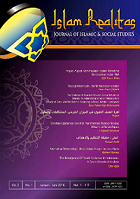THE EMERGENCE OF YOUTH VIOLENCE IN INDONESIA: A SOCIO-HISTORICAL ANALYSIS
DOI:
https://doi.org/10.30983/islam_realitas.v2i1.115Keywords:
Emergence, Youth Violence, Socio-Historical Analysis.Abstract
References
Books
Amalia, R., Komunikasi Senior dan Junior Pada Kelompok Pelajar dalam Upaya Mempertahankan Budaya Tawuran (Semarang: Undergraduate, Universitas Diponegoro Press, 2013).
Archer, L., Race, Masculinity and Schooling: Muslim Boys and Education (England: Open University Press, 2003).
Barker, G. T., Dying To Be Men: Youth, Masculinity and Social Exclusion (Oxon: Routledge, 2005).
Bloch, H., A. & Niederhoffer, A., The Gang: A Study In Adolescent Behavior (New York, Philosophical Library, 1958).
Cohen, A. K. 1964. Delinquent Boys: The Culture of The Gang (USA, The Free Press, A Corporation, 1964).
Cotterell, J., Social Networks in Youth and Adolescence (Hove: Routledge, 2007).
Emler, N. R., Stephen, Adolescent and Delinquency: The Collective Management of Reputation (Oxford: Blackwell Publishers Ltd, 1995).
Furlong, A., Youth Studies: an Introduction (Oxon, Routledge, 2013).
Hearn, J. A. P., K., “Studying In Europeâ€. In: Hearn, J. P., K and Members of Crome (Ed.) European Perspectives on Men and Masculinities: National and Transnational Approaches (Houndmills: Palgrave Macmillan, 2006).
Hirschi, T. S., Rodney, “Hellfire And Delinquency†In: South, N. (Ed.) The International Library of Criminilogy, Criminal & Penology: Youth Crime, Deviance and Delinquency (England: Ashgate Publishing Company, 1967).
Mckay, S. A. L.-P. I., D, E., “Filipino Seafarers and The Situational Performance of Manhoodâ€. In: Michele, F. A. L., Lyons (Ed.) Men and Masculinities in Southeast Asia (Oxon: Routledge, 2012).
Miller, W. B., “Lower Class Culture As A Generating Milieu of Gang Delinquencyâ€. In: South, N. (Ed.) The International Library of Criminology, Criminal Justice & Penology: Youth Crime, Deviance and Delinquency (England: Darmouth Publishing Company Limited, 1958).
Myrttinen, H., “Violence, Masculinities and Patriarchy in Post-Conflict Timor-Lesteâ€, In: Lyons., M. F. A. L. (Ed.) Men and Masculinities in Southeast Asia (Oxon: Routledge, 2012).
Parker, L. N. P., Adolescents in Contemporary Indonesia (Oxon: Routledge, 2013).
Rampton, B., Crossing: Language and Ethnicity among Adolescent (New York, Longman Group Limited, 1995)
------., Language in Late Modernity: Interaction in an Urban School, (USA: Cambridge University Press, 2006)
Stewart, B.. A Sociolinguistic Study of Verlan in The Town of Oyonnax, France. (UK: Undergraduate University of Manchester Press, 2010)
Thrasher, F., M., The Gang: A Study of 1,313 Gangs in Chicago, (Chicago, Illinois: University of Chicago Press, 2000)
Wilson, I., “The Biggest Cock: Territoriality, Invulnerability and Honour Amongst Jakarta’s Gangsterâ€. In: Michele, F. A. L., Lyons (Ed.) Men and Masculinities in Southeast Asia (Oxon: Routledge, 2012).
Winarti, L., Buking Sosis (Buku Pendamping Dan Soal-Soal Untuk Siswa) Bahasa Indonesia, Jakarta, Pemerintah Provinsi Daerah Khusus Ibukota Jakarta, Dinas Pendidikan Menengah dan Tinggi, SMA 70 Jakarta, 2011).
Journals
Akiba, M., Letendre, G. K., Baker, D. P. & Goesling, B., “Student Victimization: National and School System Effects on School Violence in 37 Nationsâ€. American Educational Research Journal, 39, 2002.
Berg, T., Talking Backwards, Looking Forwards - The French-Language Game Verlan - Lefkowitz,N. Language in Society, 21, 1992.
Bucholtz, M., ‘It’s Different for Guys’: Gendered Narratives of Racial Conflict Among White California Youth. Discourse & Society, 22, 2011.
Delisi, M., Vaughn, M. G., Gentile, D. A., Anderson, C. A. & Shook, J. J., “Violent Video Games, Delinquency, And Youth Violence New Evidenceâ€. Youth Violence and Juvenile Justice, 11, 2013.
Doran, “Alternative French, Alternative Identities: Situating Language In La Banlieueâ€, Contemporary French and Francophone Studies, 11, 2007.
Eckert, P., “Adolescent Social Structure and The Spread of Linguistic Changeâ€, Language in Society, 17, 1988
Ferguson, C. J., “Video Games and Youth Violence: A Prospective Analysis In Adolescents†Journal of Youth and Adolescence, 40, 2011.
Kadir, H. A., “School Gangs of Yogyakarta: Mass Fighting Strategies and Masculine Charisma in the City of Studentsâ€, The Asia Pacific Journal of Anthropology, 13, 2012.
Kristiansen, S., “Violent Youth Groups In Indonesia: The Cases of Yogyakarta And Nusa Tenggara Barat†Sojourn: Journal of Social Issues In Southeast Asia, 2003.
Lefkowitz, N. J., “Verlan: Talking Backwards In Frenchâ€. French Review, 1989.
Naafs, S. & White, B., “Intermediate Generations: Reflections on Indonesian Youth Studiesâ€, The Asia Pacific Journal of Anthropology, 13, 2012.
Nilan, P., “The Reflexive Youth Culture of Devout Muslim Youth in Indonesiaâ€. In: Nilan, P. A. C., F (Ed.) Global Youth: Hybridity Identities, Plural World. (Oxon: Routledge, 2006)
------, “Contemporary Masculinities and Young Men in Indonesiaâ€, Indonesia and The Malay World, 37, 2009.
------, “The Gang, “Violence and The Life Course for Indonesian Male Youthâ€, Paper for XVII World Congress of Sociology (Isa-Rc 34), Gothenburg, Sweden, 2010.
-------, Demartoto, A. & Wibowo, A., “Young Men and Peer Fighting in Solo, Indonesiaâ€, Men and Masculinities, 14, 2011.
Smithâ€Hefner, N. J., “Youth Language, Gaul Sociability, and The New Indonesian Middle Classâ€, Journal of Linguistic Anthropology, 17, 2007.
Snodgrass, J., Clifford R. Shaw And Henry D. Mckay: â€Chicago Criminologistsâ€, Brit. J. Criminology, 16, 1, 1976
Downloads
Published
How to Cite
Issue
Section
Citation Check
License
Authors who publish with this journal agree to the following terms:
- Authors retain copyright and grant the journal right of first publication with the work simultaneously licensed under a Creative Commons Attribution License that allows others to share the work with an acknowledgment of the work's authorship and initial publication in this journal.
- Authors are able to enter into separate, additional contractual arrangements for the non-exclusive distribution of the journal's published version of the work (e.g., post it to an institutional repository or publish it in a book), with an acknowledgment of its initial publication in this journal.
- Authors are permitted and encouraged to post their work online (e.g., in institutional repositories or on their website) prior to and during the submission process, as it can lead to productive exchanges, as well as earlier and greater citation of published work (See The Effect of Open Access).




